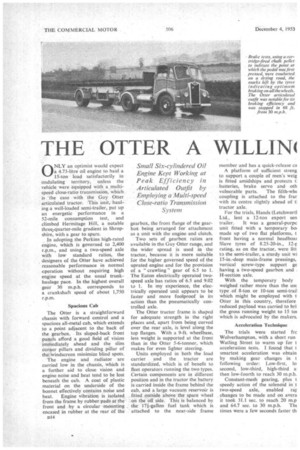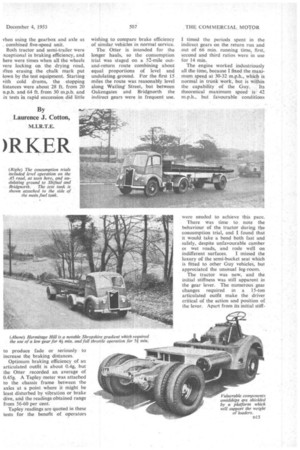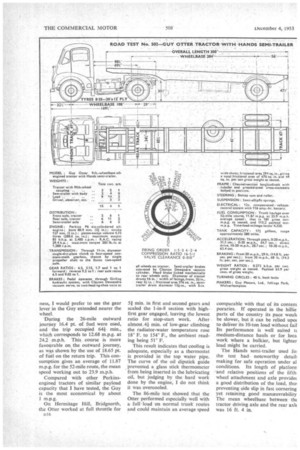THE OTTER A WILLINt )IRKER
Page 54

Page 55

Page 56

If you've noticed an error in this article please click here to report it so we can fix it.
By Laurence J. Cotton,
M.I.R.T.E.
ONLY an optimist would expect a 4.73-litre oil engine to haul a 15-ton load satisfactorily in undulating territory, unless the vehicle. were equipped with a multispeed close-ratio transmission, which is the case with the Guy Otter articulated tractor. This unit, hauling a well-loaded semi-trailer, put up an energetic performance in a 52-mile consumption test, and climbed Hermitage Hill, a notable three;quarter-mile gradient in Shropshire, with a gear to spare.
In adopting the Perkins high-rated engine, which is governed to 2,400 r.p.m., and using a two-speed axle with low standard ratios, the designers of the Otter have achieved reasonable performance in normal operation without requiring high engine speed at the usual trunkhaulage pace. In the highest overall gear 30 m.p.h. corresponds to a crankshaft speed of about 1,750 r.p.m.
Spacious Cab The Otter is a straightforward chassis with forward control and a spacious ail-metal cab, which extends to a point adjacent to the back of the gearbox. Its sloped-back front panels afford a good field of vision immediately ahead and the slim corner pillars and dividing pillar of the,windscreen minimize blind spots.
The engine and radiator are carried low in the chassis, which is a further aid to close vision and engine noise and heat tend to be lost beneath the cab. A coat of plastic material on the underside of the bonnet effectively contains noise and heat. Engine vibration is isolated from the frame by rubber pads at the front and by a circular mounting encased in rubber at the rear of the D14 gearbox, the front flange of the gearbox being arranged for attachment as a unit with the engine and clutch.
Two sets of gearbox ratios are available in the Guy Otter range, and the wider spread is used in the tractor, because it is more suitable for the higher governed speed of the uprated engine and for the provision of a " crawling " gear of 6.5 to 1. The Eaton electrically operated twospeed axle has ratios of 6.5 and 9.02 to I. In my experience, the electrically operated unit appears to be faster and more foolproof in its action than the pneumatically controlled axle.
The Otter tractor frame is shaped for adequate strength in the right places and, apart from being curved over the rear axle, is level along the top flanges. With a 9-ft. wheelbase, less weight is supported at the front than in the Otter 5-6-tonner, which makes for even lighter steering.
Units employed in both the load carrier and the . tractor are standardized, which is of benefit to fleet operators running the two types. Certain components are in different position and in the tractor the battery is carried inside the frame behind the cab, and a large vacuum reservoir is fitted outside above the spare wheel on the off side. This is balanced by the l7-gallon fuel tank which is attached to the near-side frame member and has a quick-release ca A platform of sufficient streng to support a couple of men's weig is fitted amidships and protects t. batteries, brake servo and •oth vulnerable parts. The fifth-whe coupling is attached to the frar with its centre slightly ahead of tl tractor axle.
For the trials, Hands (Letchword Ltd., lent a 12-ton export sen trailer. It was a general-purpc unit fitted with a temporary bol made up of two flat platforms, t front having a normal head boar Slave tyres of 8.25-20-in., 12-r rating, as on the tractor, were fitt to the semi-trailer, a sturdy unit wi 15-in-deep main-frame pressings, vertical screw-type support ge having a two-speed gearbox and . H-section axle.
With the temporary body weighed rather more than the use. type of 8-ton or 10-ton semi-trail which might be employed with t Otter in this country, therefore reduced payload was carried to bri the gross running weight to 15 tot which is advocated by the makers.
Acceleration Technique
The trials were started frc Wolverhampton, with a short run Watling Street to warm up for t acceleration tests. I found that t smartest acceleration was obtain by making gear changes in t following order: Low-first, second, low-third, high-third a: then low-fourth to reach 30 m.p.h.
Constant-mesh gearing, plus t speedy action of the solenoid in ,t two-speed axle, enabled rar changes to be made and on avera it took 31.1 sec. to reach 20 m.p
and 64.7 sec. to 30 m.p.h. The times were a few seconds faster th vhen using the gearbox and axle as . combined five-speed unit.
Both tractor and semi-trailer were :xceptional in braking efficiency, and here were times when all the wheels veto locking on the drying road, )ften erasing the chalk mark put lovvn by the test equipment. Starting vith cold drums, the stopping listances were about 28 ft. from 20 n.p.h. and 64 ft. from 30 m.p.h. and ix tests in rapid succession did little to produce fade or seriously to increase the braking distances.
Optimum braking efficiency of an articulated outfit is about 0.4g, but the Otter recorded an average of 0.45g. A Tapley meter was attached to the chassis frame between the axles at a point where it might be least disturbed by vibration or brake dive, and the readings obtained range from 56-60 per cent.
Tapley readings are quoted in these tests for the benefit of operators wishing to compare brake efficiency of similar vehicles in normal service.
The Otter is intended for the longer hauls, so the consumption trial was staged on a 52-mile outand-return route combining about equal proportions of level and undulating ground. For the first 15 miles the route was reasonably level along Watling Street, but between Oakengates and Bridgnorth the indirect gears were in frequent use I timed the periods spent in the indirect gears on the return run and out of 66 min. running time, first, second and third ratios were in use for 14 min.
The engine worked industriously all the time, because I fixed the maximum speed at 30-32 m.p.h., which is normal in trunk work, but is within the capability of the Guy. Its theoretical maximum speed is 42 m.p.h., but favourable conditions were needed to achieve this pace.
There was time to note the behaviour of the tractor during the consumption trial, and I found that it would take a bend both fast and safely, despite unfavourable camber ot wet roads, and rode well on
indifferent surfaces. I missed the luxury of the semi-bucket seat which is fitted to other Guy vehicles, bui appreciated the unusual leg-room.
The tractor was new, and the initial stiffness was still apparent in the gear lever. The numerous gear changes required in a 15-ton articulated outfit make the driver critical of the action and position of the lever. Apart from its initial stiff ness, I would prefer to see the gear lever in the Guy extended nearer the wheel.
During the 26-mile outward journey 16.4 pt. of fuel were used, and the trip occupied 64* min., which corresponds to 12.68 m.p.g. at 24.2 m.p.h. This course is more favourable on the outward journey, as was shown by the use of 18.65 pt. of fuel on the return trip. This consumption gives an average of 11.87 m.p.g. for the 52-mile route, the mean speed working out to 23.9 m.p.h.
Compared with other Perkinsengined tractors of similar payload capacity that I have tested, the Guy is the most economical by about 1 m.p.g.
On Hermitage Hill, Bridgnorth, the Otter worked at full throttle for D16 5f min. in first and second gears and scaled the 1-in-8 section with highfirst gear engaged, leaving the lowest ratio for stop-start work. After almost 44 min. of low-gear climbing the radiator-water temperature rose 18° F. to 154° F., the ambient reading being 51° F.
This result indicates that cooling is adequate, especially as a thermostat is provided in the top water pipe. The curve of the oil dipstick guide , prevented a glass stick thermometer from being inserted in the lubricating oil, but judging by the hard work done by the engine, I do not think it was overcooled.
The 86-mile test showed that the Otter performed especially well with a fullload on normal trunk routes and could maintain an average speed
comparable with that of its contem poraries. If operated in the hillie parts of the country its pace woul( be slower, but it can be relied upor to deliver its 10-ton load without fail Its performance is well suited tt , medium-distance hauls or for loca work where a bulkier, but lighter load might be carried.
The Hands semi-trailer used foi the test had noteworthy detail: making for safe operation under al conditions. Its length of platform -'and relative positions of the fifthwheel attachment and axle providec a good distribution of the load, thu! preventing side slip in fast cornering yet retaining good manceuvrability The mean wheelbase between tht tractor driving axle and the rear axh was 16 ft. 4 in.
































































































